Modern full-backs have become a rare breed with those of the highest quality in most demand. Many of the new systems employed by managers heavily involve the use of full-backs or wing-backs as an integral part of the build-up phase. Juventus were on the search for a new right-back last summer with Stephan Lichsteiner having left at the end of his contract, prompting the purchase of Portuguese right-back Joao Cancelo.
Pep Guardiola is renowned for his use of full-backs in an unorthodox fashion making Manchester City one of the most feared oppositions in European football today. His usage of Kyle Walker and Benjamin Mendy – when fit – has been devastating, to say the least. Full-backs are more than just defenders now. They are a gateway between defence and attack allowing wide forwards and wingers the freedom to move inside or stay out wide.
Mendy and Walker cost Manchester City £50 million emphasising the value to Guardiola. Jurgen Klopp had prioritised the need for effective and efficient full-backs by introducing Trent Alexander-Arnold and Andrew Robertson who has been monumental to Liverpool’s Premier League and Champions League run in recent seasons. The level required to perform at the highest level is ever-growing and modern full-back must adapt accordingly.
Juventus have been reliant on their full-backs since Antonio Conte’s three-year reign where he employed a 3-4-3 formation using the two wing-backs as the fundamental base of his formation. Massimiliano Allegri continued that tradition by allowing his full-backs to push forward and assist the forward line with their latest acquisition changing their attacking dynamic.
Joao Cancelo had been thought to be securing a permanent move to Inter Milan after a one-year loan spell, but Juventus swiftly swooped in once the Nerrazurri decided against it. Cancelo’s transfer fee of £40 million raised a few eyebrows but he has silenced his critics. The Portuguese full-back has been one the Bianconeri’s most important players with his potent attacking and speed threat. His form has been stable having made 26 appearances this season; Cancelo has finally produced consistency at a high level.
I will look to dissect the Portuguese full-back’s qualities and the capabilities he brings to this Juventus team.
Joao Cancelo: Juventus’ marauding right-back
The 24-year-old right-back is a versatile player that can play across various positions. A right-winger in his youth, Cancelo was converted into an attacking right-back with incredible delivery and output.
The Portuguese defender looks to get forward at every opportunity with a preference to cross rather than play inside the channels. With a preference to hug the touchline, he looks to take advantage of Juventus’ superior forward line which includes the likes of Mario Mandzukic and Cristiano Ronaldo.

The Portuguese wing-back is best suited to a system that allows its full-backs attacking freedom. His skill set suits a three-man defensive formation over a four-man system. This allows Cancelo to foray forward and have enough cover from his centre-back and defensive midfielder. A four-man formation lacks the defensive cover for the attacking defender and requires exceptional positioning and concentration to play the position diligently.
He attempts 6.95 dribbles per game with a 67.8% success rate, mirroring his preference to play further up the pitch. Having taken all the attributes of a traditional winger, Cancelo has applied those skills to his right-back position and more often than not is able to terrorise opposition defences with his direct running and pace. Teams are forced to double up on him to try and contain his attacking intent, leaving space for Juve’s winger or attacking-midfielder to exploit.
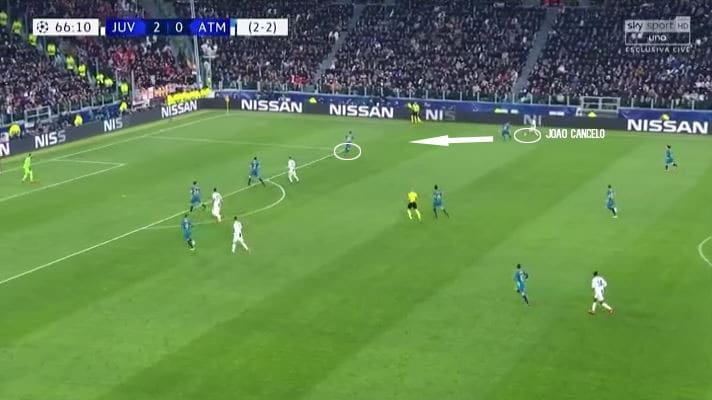
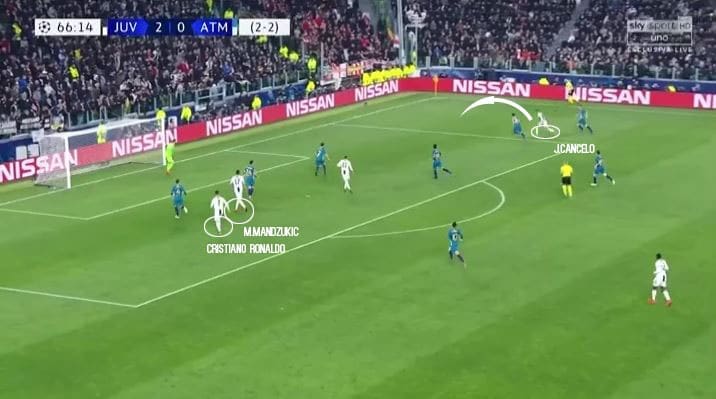
During the recent Champions League match against Atletico Madrid, the two full-backs – Joao Cancelo and Leonardo Spinazzola – were instructed to stay high and wide. In this example, we can see Cancelo dribbling from deep with three targets to aim for. However, the better crossing opportunity would come in the space behind the opposition left-back. Not only does he beat the first man, but is able to bypass the covering defender using his immense pace and ability to deliver a cross towards Mandzukic and Ronaldo.
However, he encounters difficulties against defenders with great positional sense who are able to negate his raw pace and ability to keep him away from the penalty area. The Portuguese international has been able to adjust when using his footballing intelligence and creating space for his teammates. Playing in the likes of Paulo Dybala and Emre Can has shifted the focus off him and onto the onrushing midfielders.
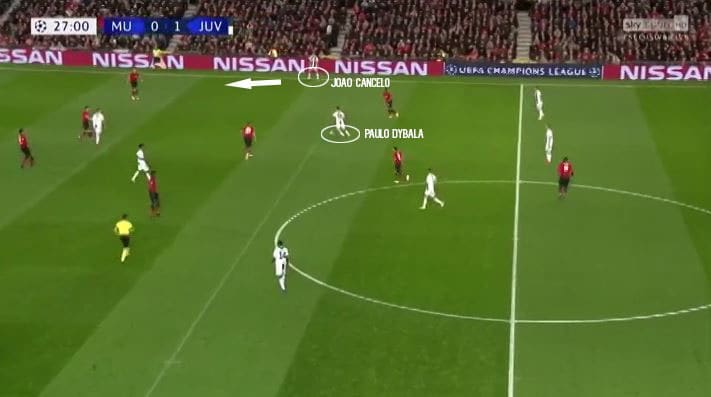
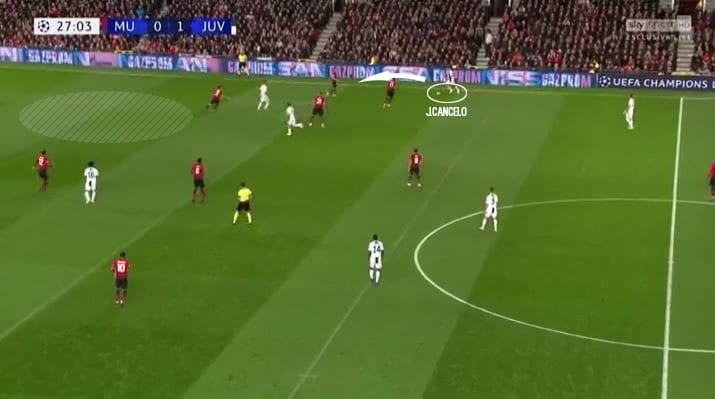
Averaging 1.5 key passes per game, Cancelo looks to find these attacking players and play them into into goalscoring positions to create clear cut chances. If these options are limited, Juventus usually try to switch play to the opposite flank by bringing the left-back into play.
Joao Cancelo’s individual skill is evident but the Portuguese right-back has also developed an understanding with his teammates. Developing a relationship with his right-winger has been vital towards Juventus’ success going forward. The Bianconeri have wingers of different profiles.
In Juan Cuadrado they have a traditional winger who prefers staying out wide and floating in crosses for the strikers. This gives Joao Cancelo the option to move either side of his Colombian teammate using their pace in tandem to get behind defensive lines.
However, Federico Bernardeschi and Douglas Costa have the ability to play both as inside forwards or wide wingers. The Italian’s quick movement pattern allows Cancelo to thrive on the overlap and remain unmarked giving Bernardeschi the option to take on a shot or pass it to Cancelo for a crossing opportunity.
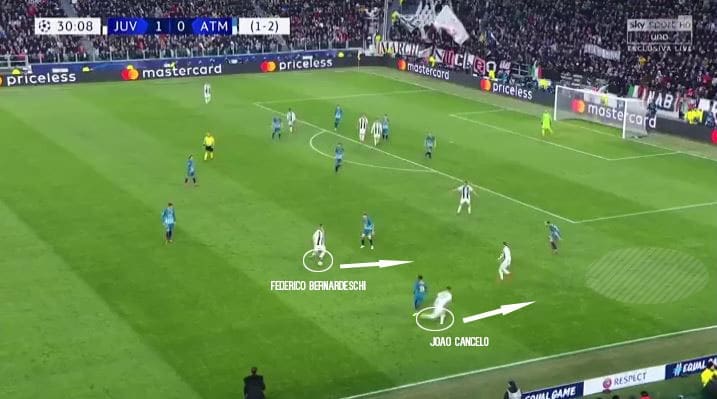
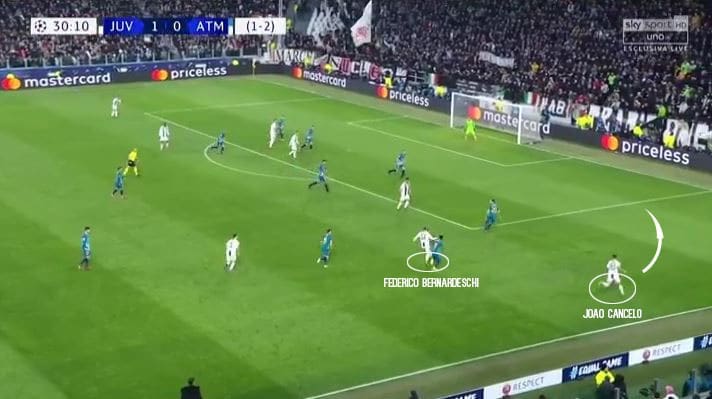
Defensive frailties
A right-back should possess sound defensive capabilities but the Portuguese international struggles in this aspect. Usually, Portuguese full-backs are better known for their attacking abilities leaving the astute defending to their impressive centre-backs. The likes of Raphaël Guerreiro, Cedric Soares, Nelson Semedo and Mario Rui are all known for their attacking exploits and have proved so for both club and country.
Joao Cancelo is defensively weaker than other right-backs due to a deficiency of defensive positioning and awareness. Even with his extreme pace, he struggles to maintain his position and hold a level of concentration required to defend under periods of extreme pressure.
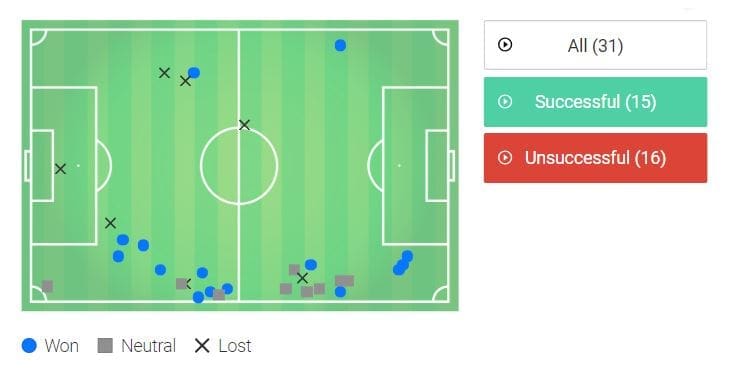
Taking the recent Champions League second leg knockout tie against Atletico Madrid, we can see Cancelo only had a 49% success rate when it came to winning challenges. Even though some of the challenges were won in the defensive third, they were also lost in crucial areas near Juve’s own goal. He averages 23.26 duels per 90 minutes but yields a 44.3% success rate.
His enthusiasm and energetic play style contribute to his lack of concentration. Having been regarded as one of the biggest prospects in world football in 2017, his defensive weaknesses were highlighted but seen as inexperience stemming from a lack of game time. But after playing for Valencia, Inter Milan and Juventus, his struggles have continued.
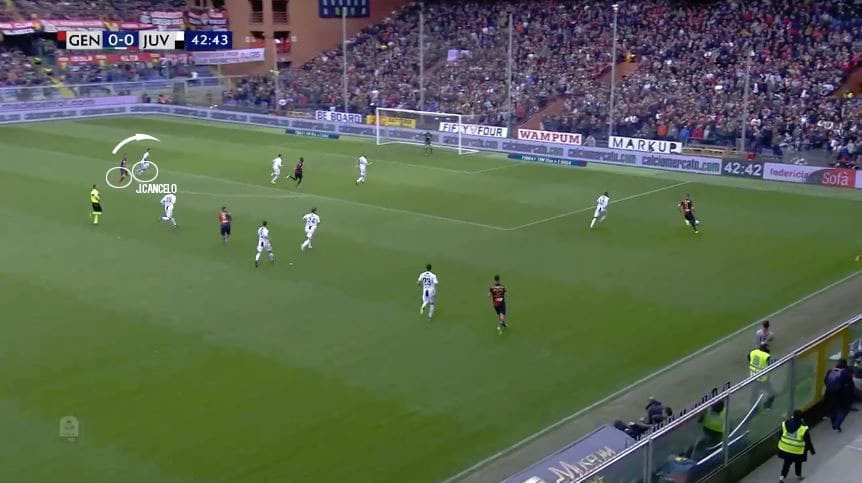
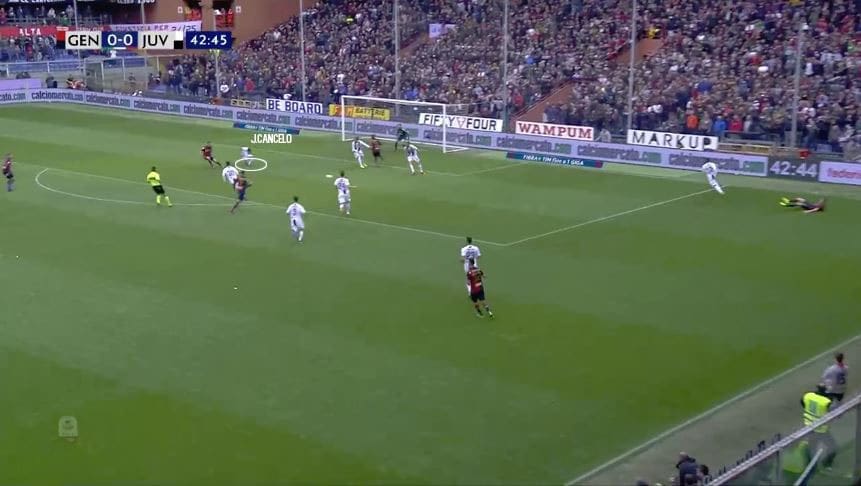
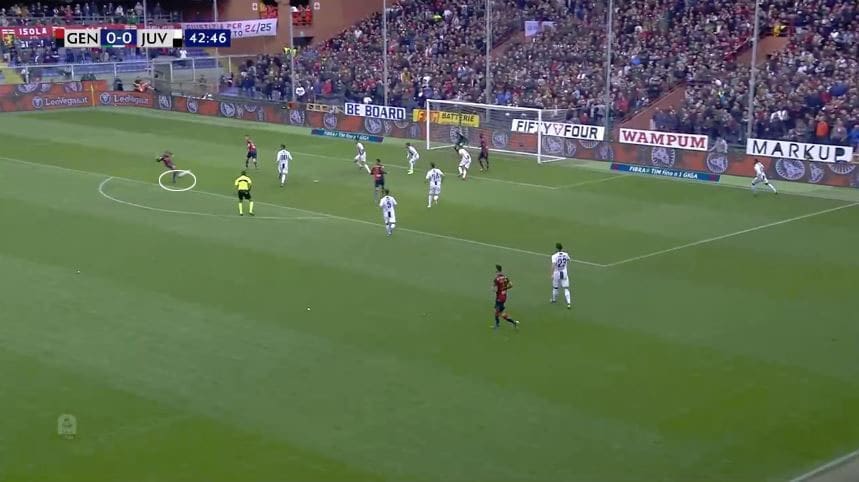
This example here in the match against Genoa shows his positional issues. Having lined up in a 3-1-4-2 formation, Juve’s wing-backs in Alex Sandro and Joao Cancelo were positioned slightly higher.
However, in this situation, you can see Cancelo is a few yards ahead of the opposition winger but is ball watching. The immediate turn causes him to slip allowing Genoa a shot at Juventus’ goal. In this instance Genoa did not take advantage, but this sort of indiscipline can cause Juventus major issues.
Portuguese nomad
Joao Cancelo looks to have found a home at Juventus and his performances have endeared him at the Allianz Stadium. After a nomadic career spent at the likes of Benfica, Valencia and Inter Milan, Juventus stepped in after Inter passed on their buying option and took the Portuguese right-back under their wing.
Even though his defensive capabilities are called into question, his attacking ability is threatening and dynamic. The marauding right-back can still develop at 24 years of age under a coach that will look to nurture talent. With Allegri rumoured to be moving on from Juventus after a trophy-laden few seasons, the next coach could look to invest time into the young right-back to help him have the same effect as Hector Bellerin at Arsenal under Unai Emery.
Under their current 4-3-3 or 3-1-4-2 system, they can afford to allow the free flowing Cancelo to attack the right wing with Emre Can and Blaise Matuidi able to cover the space he leaves behind. However, he thrives as a wing-back rather than a full-back due to the nature of his play. His performances will only get better and works on confidence.
Having a compatriot in Cristiano Ronaldo is a huge confidence boost for the young Portuguese right-back. There was a moment during the Champions League match against Atletico Madrid after Ronaldo scored when he ran up to Cancelo and whispered a few words of confidence.
That gesture would have meant the world to Cancelo. Having your country’s icon give you a few words would have raised his game immensely. Joao Cancelo might yet be moved back into midfield, but till then the young right-back is repaying the faith Juventus have placed in him.
If you love tactical analysis, then you’ll love the digital magazines from totalfootballanalysis.com – a guaranteed 100+ pages of pure tactical analysis covering topics from the Premier League, Serie A, La Liga, Bundesliga and many, many more. Buy your copy of the March issue for just ₤4.99 here, or even better sign up for a ₤50 annual membership (12 monthly issues plus the annual review) right here.

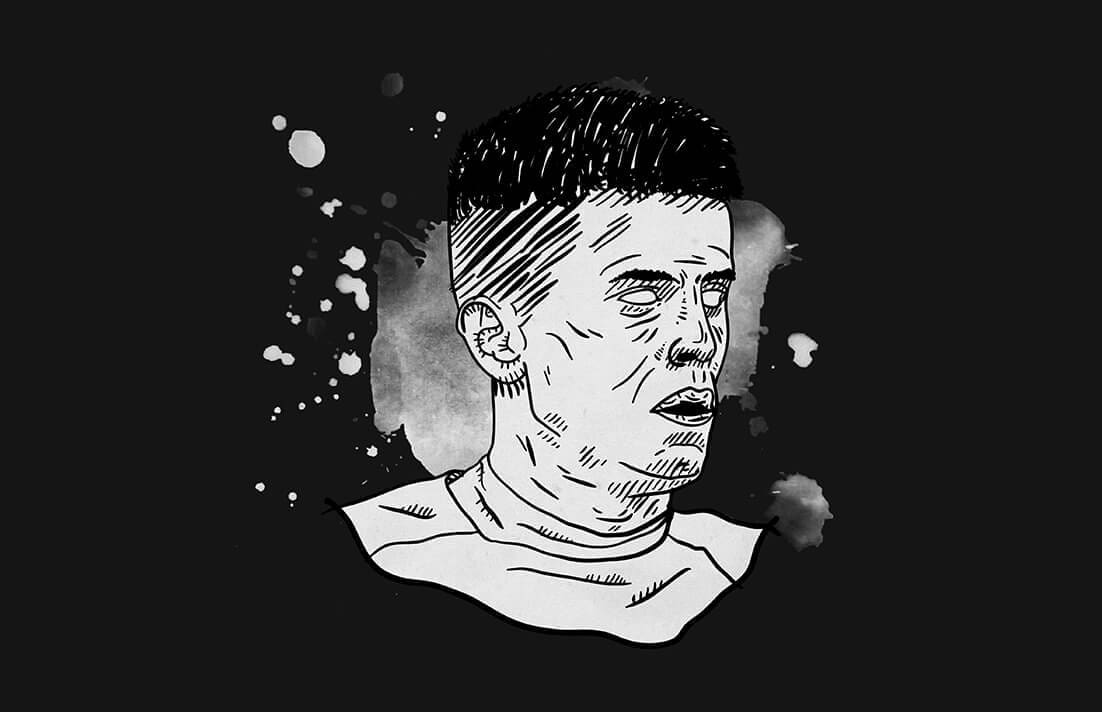




Comments